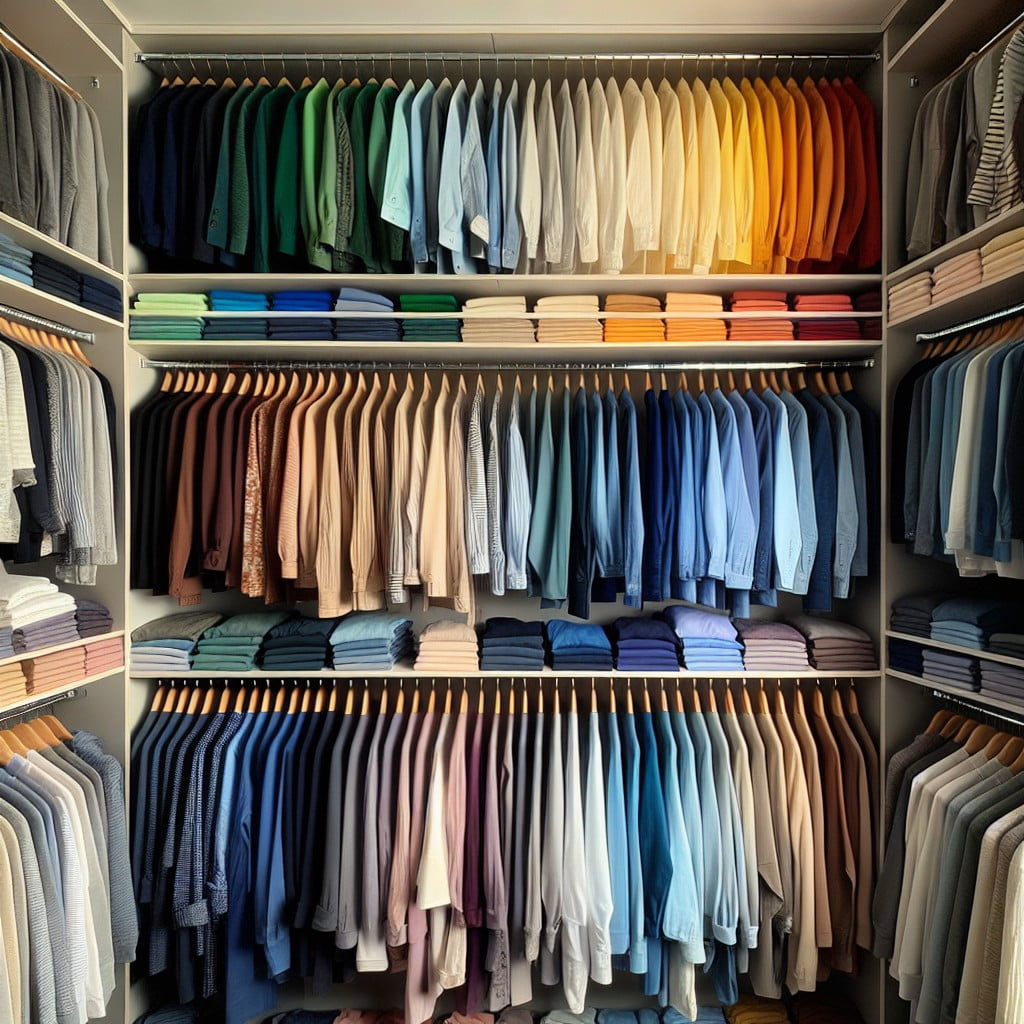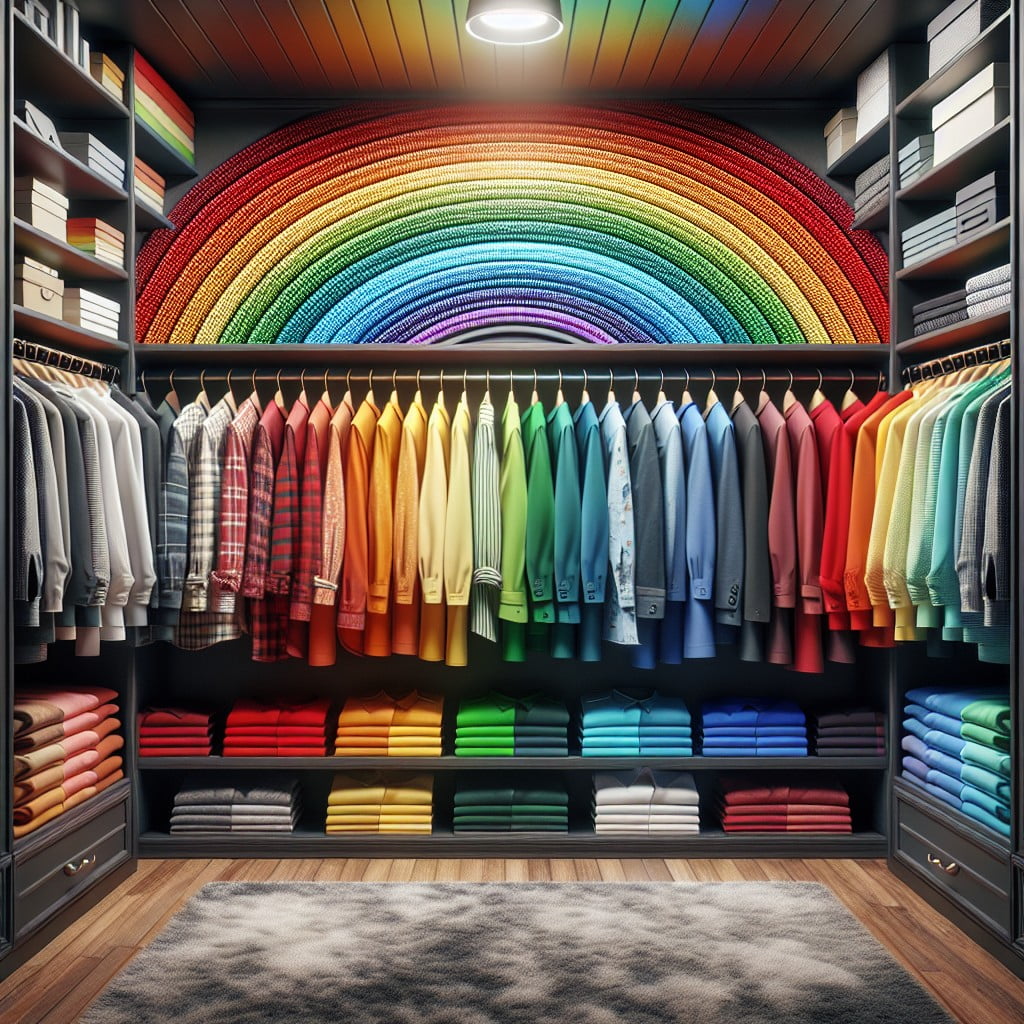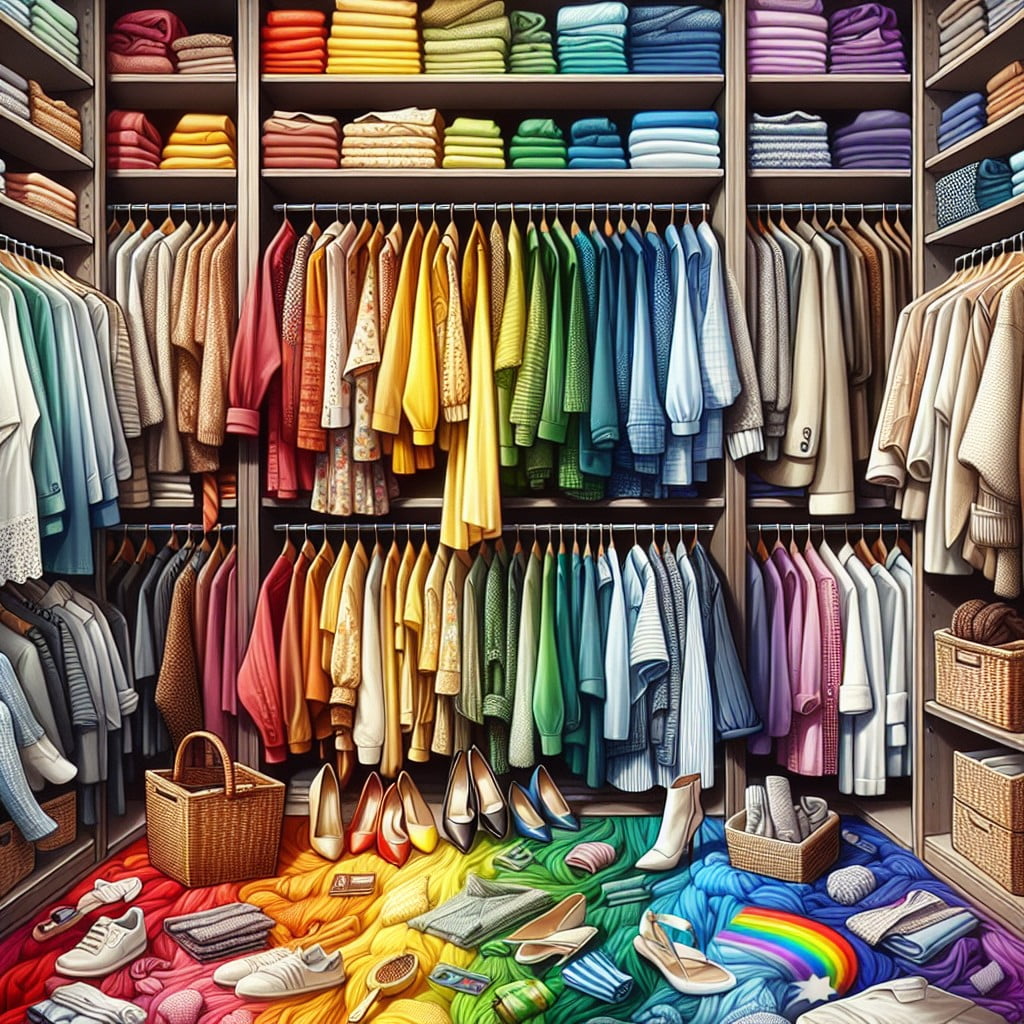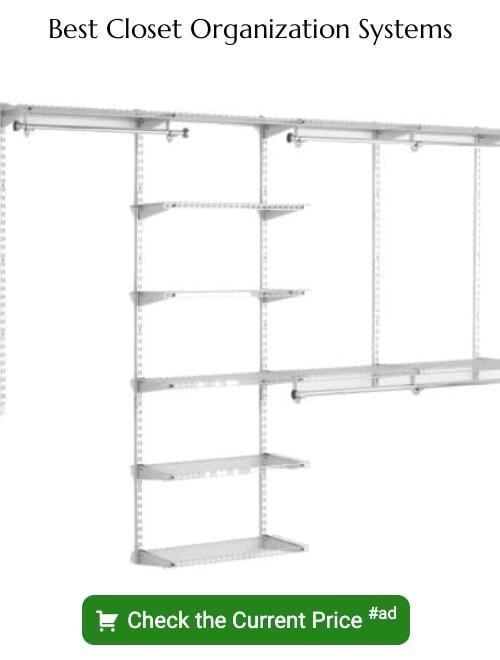Last updated on
Untangling the mayhem in your wardrobe becomes a breezy affair because color coding your clothes not only streamlines your closet, but it also simplifies your morning dress-up routine.
Key takeaways:
- Simplified Decision Making: Color coding makes choosing outfits quicker and stress-free.
- Efficient Space Use: Grouping clothes by color optimizes closet space.
- Wardrobe Rotation: Color coding ensures all clothes are seen and worn regularly.
- Laundry Efficiency: Sorting laundry by color saves time and prevents color bleeding.
- Stylistic Creativity: Seeing your color palette inspires creative outfit combinations.
Benefits of Color-Coded Clothes Organization

Color-coded clothes organization offers multiple advantages, enhancing both the functionality and aesthetics of your wardrobe:
- Simplified Decision Making: When arranged by color, choosing outfits becomes a swifter, more streamlined process, reducing the time and stress of getting dressed.
- Efficient Space Use: It’s easier to identify and store clothes optimally when they are grouped by color, often leading to more effective use of closet space.
- Wardrobe Rotation: This system encourages you to see and wear all your clothes, preventing certain items from being overlooked or forgotten.
- Laundry Efficiency: Sorting your laundry into colors beforehand can make the washing process quicker and protect your garments from color bleeding.
- Stylistic Creativity: Being able to see the color palette of your wardrobe can inspire more creative combinations and ensure a varied usage of your clothes.
By adopting a color-coded approach, you can reap these practical benefits daily, resulting in a more organized lifestyle and a visually appealing closet space.
Choosing Your Color-Coding Strategy

Selecting an effective color-coding system aligns with personal preference and lifestyle. Two common strategies include:
1. Rainbow Order: Mimic the natural order of colors as they appear in a rainbow, starting with red and ending with violet. This method not only provides visual appeal but also makes it easy to locate specific items.
2. Light to Dark: Arrange clothes from the lightest hues to the darkest, which can be particularly useful for creating outfits based on color depth and ensuring that lighter, more delicate items are easy to find.
Another consideration is whether to group by color within each type of clothing or to mix types but keep colors together. For example, you might hang all blue garments next to each other regardless of whether they are shirts, pants, or dresses, or you might separate shirts into one color-coded area, pants into another, and so on.
The key is to choose a system that feels intuitive, simplifies decision-making, and enhances your daily routine. Once your strategy is set, the process of organizing your closet becomes much simpler and more efficient.
Assessing Your Wardrobe

Before diving into a color-coding system, take inventory of your clothing. This step ensures that you are aware of all the items you have and what you actually wear. Begin by removing everything from your closet and drawers. Categorize each piece into distinct piles such as tops, bottoms, dresses, outerwear, and accessories.
As you sort, consider the following points:
- Condition: Examine each item for wear and tear. If something is damaged or no longer fits, set it aside to donate, repair, or recycle.
- Frequency of Use: Ask yourself when you last wore each item. If it hasn’t been worn in over a year, it might be time to let it go.
- Versatility: Identify pieces that can be mixed and matched with ease. These items will become staples in your color-coordinated closet.
- Seasonality: Acknowledge which items are for specific seasons. These can be separated and stored when not in use.
This process not only helps in simplifying your wardrobe but also forms the foundation for a well-organized, color-coded system that reflects your personal style and daily needs.
Sorting Clothes By Color

To get started, gather all your clothing items in one area. Create distinct piles for each color group—whites, blacks, grays, reds, blues, greens, yellows, purples, and so on. For the most effective sorting:
1. Stick to the basics: Begin with clear-cut colors before tackling multicolored items or patterns.
2. Embrace shades: Within each color group, organize clothes from light to dark. This not only looks aesthetically pleasing but can also help you locate the right shade for your outfit more easily.
3. Consider frequency: If certain colors dominate your wardrobe, separate them further if it will make daily selections simpler.
4. Handle patterns carefully: Items with multiple colors can fall into the pile that matches the background or the most dominant color.
5. Think seasonally: If you’re sorting at a seasonal transition, make piles for storage of off-season clothing.
By differentiating colors and understanding your wardrobe’s color palette, your outfit selection process becomes streamlined and efficient.
Organizing Clothes By Color in the Closet
Once your wardrobe has been segmented by hue, it’s time to put this system into action within your closet. Arrange garments from light to dark to create a visually appealing gradient that makes selection a breeze. Begin with the whites and creams, transitioning naturally through the color spectrum toward darker shades like navy and black. This not only aids in locating items effortlessly but also lends an aesthetically pleasing uniformity to your space.
For maximum efficiency, sort clothes further by type within each color category. Hang dresses, shirts, and jackets together, and stack folded items such as sweaters or jeans. This refinement saves time and keeps your closet functional.
To avoid an overcrowded closet, use slim, non-slip hangers of the same color. This trick adds cohesion and prevents clothes from slipping off, ensuring your organization stays intact. With this simple yet effective arrangement, outfit planning becomes quicker, transforming your daily routine into a smooth and enjoyable process.
Maintaining Your Color-Coded System
Keeping your color-coded closet in prime condition hinges on routine maintenance, ensuring the system continues to work for you.
Start by making it a habit to return clothes to their designated color sections after laundry.
If you purchase new items, immediately integrate them into the correct color zone to avoid a jumbled mess later on.
When seasons change, take the opportunity to reassess and reorganize, keeping the palette consistent.
If you notice certain colors are dominating your closet, consider whether it’s time to diversify your wardrobe or donate items you no longer wear.
Lastly, use consistent hangers to maintain a clean, orderly appearance that complements your organizational efforts.
Color-Coding for Different Seasons
Effectively transitioning your wardrobe between seasons can be streamlined with a color-coding system that takes temperature changes into account. In the warmer months, position lighter, brighter colors towards the front of your closet. Think crisp whites, vibrant yellows, and cool pastels that reflect the summer mood. As the weather cools, rotate these pieces to make room for the richer, deeper hues of autumn and winter wear like burgundy, navy, and forest green, which will not only match the season’s vibe but also the typically heavier, warmer clothing associated with it.
In spring, a mix of both winter and summer colors might be needed as weather can fluctuate. Having transitional colors like light blues, pinks, and grays within easy reach can make adjusting to unpredictable spring temperatures simpler. This not only keeps your closet looking seasonally appropriate but also helps to remind you of pieces that work best for layering as conditions change.
By aligning your clothing colors with the hues of nature during each season, you’ll save time on selection and feel more attuned with the time of year. Plus, it makes the process of finding those weather-appropriate clothes a breeze when you’re getting ready in a hurry.
Integrating Patterns Into a Color-Coded System
When integrating patterns into your color-coordinated wardrobe, the key is to find a balance without disrupting the flow of colors. Start by identifying the base color of each patterned item—this is typically the most dominant or background color. Place these items within their corresponding color sections in your closet.
Stripes, plaids, polka-dots, and other patterns with multiple colors can be organized by taking the following steps:
- Group stripes or items with similar patterns together, sorting them within their base color section. For example, stack striped blue shirts with solid blue ones.
- Treat plaid as you would stripes; the most prominent color dictates placement.
- For items with an all-over print, such as floral or abstract, determine the general palette and align with the closest color section.
- If the patterned piece is multicolored but lacks a dominant color, organize it at the end of the closest color section or designate a separate space for multicolored items.
This method keeps your closet visually pleasing and simplifies finding patterned pieces that complement your solid-colored clothing.
Using Color to Prioritize Wardrobe Pieces
Applying a color-coded approach to your wardrobe can also help you prioritize items based on frequency of use or occasion. Here’s how to leverage color for wardrobe prioritization:
1. Hues for Daily Wear: Designate a color spectrum for clothes you wear regularly. For instance, neutrals like blacks, grays, and whites could be easily accessible for everyday attire.
2. Splash of Color for Special Events: Reserve bright colors or unique shades for special occasion outfits. This helps them stand out in your closet, signaling that they are meant for less frequent, event-specific use.
3. Seasonal Shades: Rotate clothing by season with color cues. Cool tones for winter wardrobes and warm, vibrant colors for summer selections can help you quickly find what’s appropriate for the weather.
4. Workout Wardrobe: If you have activewear, designate a specific color range like blues and greens for quick access before a workout.
5. Professional Palette: For work attire, choose a unified color family that reflects the formality of your workplace. This simplifies morning selections and ensures your workwear is always at the ready.
By assigning significance to different colors within your closet, you create a visual guide that aids in daily decision-making and keeps your wardrobe functioning efficiently.
The Psychology of Color in Wardrobe Organization
Understanding the psychological impact of color can greatly enhance your daily routine. Colors are not just a part of our visual perception but also influence our emotions and behaviors. For instance, blues and greens tend to have a calming effect and might be perfect for your loungewear or bedclothes. In contrast, reds and oranges are vibrant and can give a boost of confidence—ideal for days when you have important meetings. Yellow often evokes happiness and can be the pick-me-up needed for dull mornings.
When organizing your wardrobe, consider the mood each color incites. You might arrange work attire in neutrals like black, gray, and navy for professionalism, while reserving brighter hues for leisurewear. Additionally, the ease of locating a color-coded outfit aligns with a stress-free start to the day. Consequently, incorporating the psychology of color into your clothing organization can not only streamline your selection process but also subconsciously set the appropriate tone for your daily activities.
FAQ
How do you color code clothes?
To color code clothes, you can arrange them in the order of the colors of the rainbow (red, orange, yellow, green, blue, indigo, and violet), followed by neutrals such as white, tan, brown, grey, and black, and create a separate section for patterned items or group them based on their dominant color.
How do you sort clothes by color?
To sort clothes by color, make distinct piles for white items (such as sturdy white cotton socks, underwear, and t-shirts), light-colored items (including colors like pink, lavender, light blue, light green, and yellow), and dark clothing.
How do you organize by color?
Organizing by color involves following the spectral sequence of white, cream, pink, red, orange, yellow, green, blue, indigo, violet, brown, gray, and black, although harder-to-place hues like gold and silver may require special consideration.
How do I organize my wardrobe by color?
To organize your wardrobe by color, allocate specific sections for each category of garment, such as sweaters, skirts, and pants, then arrange these categories by the colors in this order: white, tan, pink, red, orange, yellow, green, blue, indigo, violet, gray, and black for a satisfying rainbow effect.
What are the benefits of color coding your wardrobe?
Color coding your wardrobe offers benefits such as easy navigation, time-saving, improved visual aesthetics, and efficient space utilization.
How do different color arrangements influence the perception of your wardrobe?
Different color arrangements in a wardrobe can significantly impact an individual’s perception of style, mood, and personality, by influencing the visual, psychological, and cultural aspects of their clothing choices.
What are practical tips for maintaining a color-coded clothes organization?
To maintain a color-coded clothes organization, sort clothes by color, use dedicated bins or drawers per color group, follow the color order consistently, store garments vertically for easy view, label compartments if necessary, and regularly maintain the system with new laundry.
Recap:





